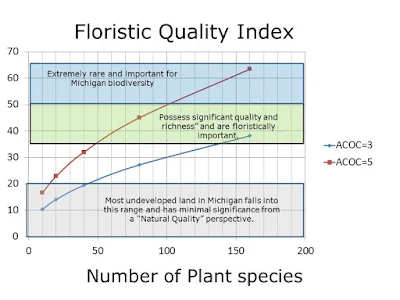It made my head hurt.
Floristic Quality Index
The current state of the art as practiced in Michigan revolves around a concept call Floristic Quality Indices.
Every species is issued a Coefficient of Conservatism on a state-by-state basis. A species, like Shumard Oak, that is common in southern Indiana might be extremely rare in Michigan. Therefore Indiana might give Shumard Oak a COC of 4 while Michigan gives it a COC of 8.
Trained botanists survey the site (i.e., walk around it in a semi-organized way) and list all of the species they see.
The Floristic Quality Index is calculated with the following formula:
=sum(COC)/sqrt(number of species identified)
So the original goal was to develop a metric that incorporated botanical evidence and spit out a composite value of "pristine" + "uniqueness".
And it mutated
For lack of a better metric, the FQI was put into use as a way to quantify the quality of a "wetland". This became a big deal as Wetland Mitigation and Wetland Banking/Compensation impacted property development. The environmentalists wanted to ensure they were trading like-quality for like-quality. The developers did not want to be held to an arbitrary, subjective, moving standard.
The FQI has some shortcomings in this application, in part, because it was not formulated for this use.
Shortcomings
The quality of the FQI is only as good as the quality of the botanist and that makes FQI "gamable". For example, there are 180 different "sedges" listed for Michigan. Sedges are incredibly boring, grasslike plants that grow in marshy places. 41 of those sedges have a COC of 10. An extremely diligent botanist might identify so many species of sedges as to make it impossible to match the FQI in the replacement wetland. Conversely, a morally lax botanist might fail to identify "COC=10" sedges in the natural wetland or creatively misidentify sedges in the compensitory wetland to make matching quality an easy task.
Another shortcoming is that adding common (ubiquitous) species to the list results in a lower FQI score. I made a list, from memory, of native plant species that are on my ten acres. The list contained 58 species and had a FQI score of 26. I removed the common species (COC of 1 and 2). The species count went down to 37 and the FQI went up to 28.
Adding non-native species reduces the FQI. Non-native species have a COC of zero but identifying them adds to the number of species (which shows up in the denominator). The botanist can move the FQI around simply by how hard they want to work at identifying non-native species. (Note: The ERJ survey discussed in the previous paragraph did not count any non-native species)
This may be a subtle point, but some species that are rare in native, natural settings are very common in domestication. Sycamore, Honey Locust and Pin Oak are rare in-the-wild but are over-planted horticulturally. Are they rare? Should they be used in wetland reconstruction because they have a high COC?
FQI does not comprehend whether the plant community produces viable seeds. The botanist only needs to identify one individual. A single individual is a slender reed (genetically) upon which to repopulate a habitat. Inbreeding depression often manifests as "poor livability".
If reconstructed wetlands are expected to function as "genesis" sites so recovering habitats can repair themselves, it makes more sense to plant three Q. bicolor (rarely used in landscaping) from widely different areas rather than a single specimen of Sycamore, Honey Locust and Pin Oak. Even better if at least one of the Q. bicolor clones has exceptionally buoyant acorns so flood waters can sweep them away and colonize downstream. Southeast Michigan has several rivers (Huron, Clinton, River Rouge) where this would be an effective technique.
Professional managers want to Manage By Objective. FQI looks like a wonderful metric. The problem is that FQI is a rearview mirror objective. It is blind to the risks that will cause it to tank. Risks like mud boggers, wild hogs, de-icing salt intrusion, fertilizer runoff, aggressive exotics like Phragmities, Phalaris,
Ligustrum or Rhamnus.
On the positive side....there has never been more interest in managing property for wildlife. These people are beyond passionate. One of the most exciting concepts from a wetlands standpoint is the concept of "refuge". It does no good to raise thirty point buck if your activities will push him onto your neighbor's land. Quality Deer Management refuges (or sanctuaries) can be awesome test beds for wetland management.
---I think it is time to pull my head out of the rabbit hole and get back to life.---
Bonus link: A case study.

Why would one want to mitigate a wetland? Nature generally abhors them, long term. Most wetlands dry up or move over the space of a generation. Even our swamps in Louisiana are constantly changing. Water moves, water flows, water erodes. If water stands still, it stagnates, dries up, or fills in the land.
ReplyDeleteDon't worrry about wetlands. They'll be fine if you just leave them alone.
Few states are as richly blessed as Louisiana with wetlands.
DeleteMost folks probably agree with you about wetlands, even people outside of Louisiana. However, various governmental regulatory and permitting organizations can obstruct development when the landowner runs afoul their agenda. Sometimes that agenda involves wetlands.
As a landowner, sometimes it seems like you are being bullied. Sometimes you are. Being able to ask a few jargon/tech-speak questions can slow them down and make the wary...like asking the percentage of genus "Carex" (sedges) represented in the survey.
Just sayin'.